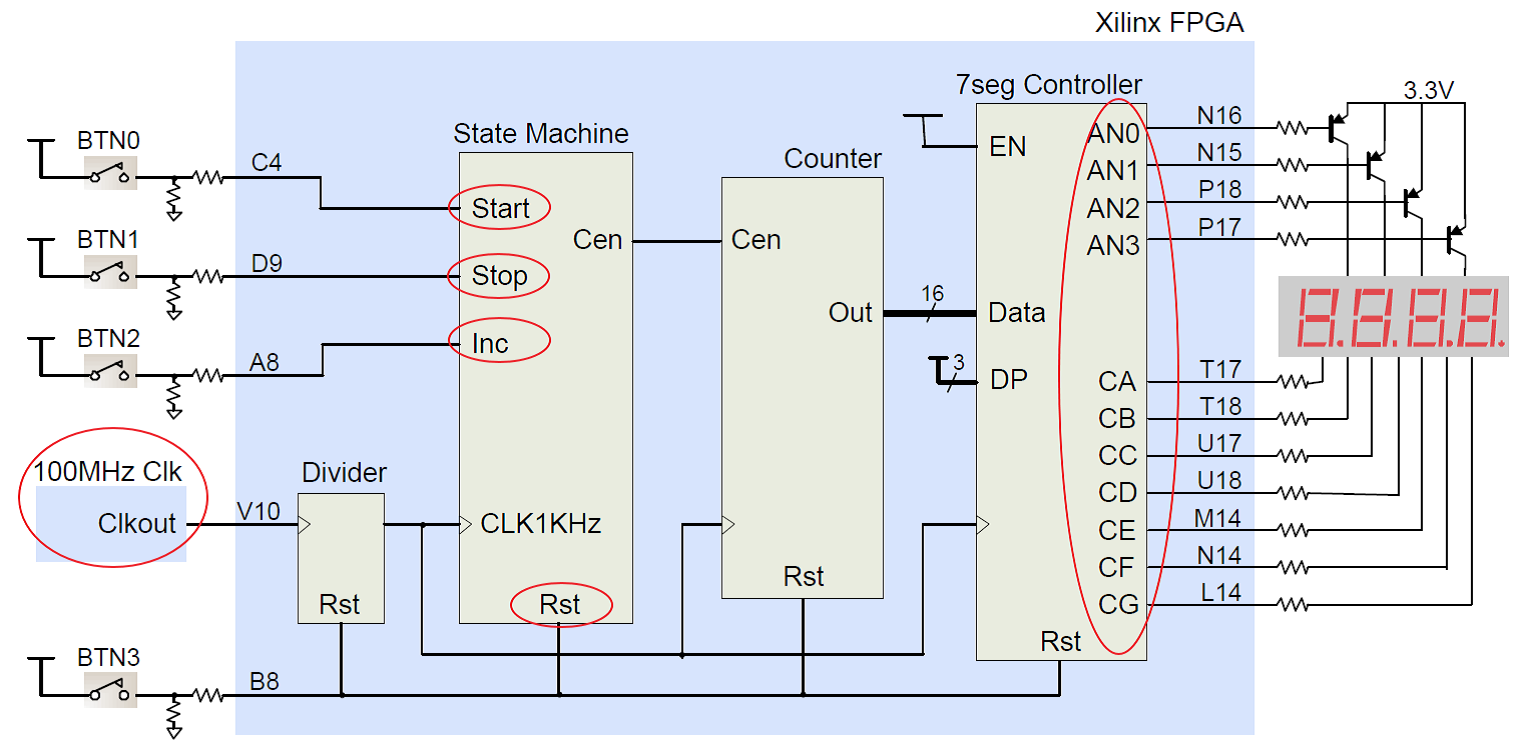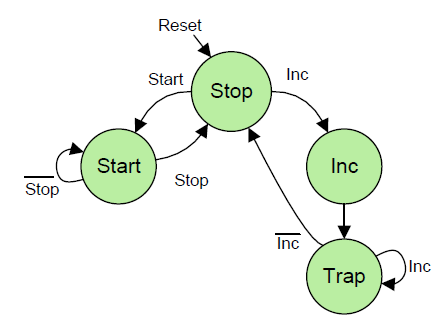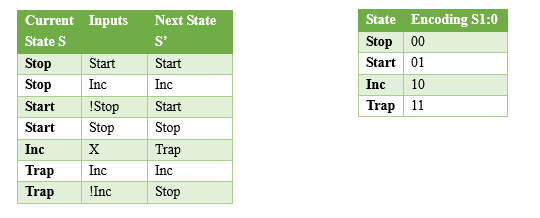verilog实现毫秒计时器
整体电路图

实验状态图

Stop代表没有计时,Start代表开始计时,Inc代表计时器加1,Trap代表inc按钮按下去时候的消抖状态。
状态编码表

实验设计思路
- 时钟分频:用一个diver=49999来让count从0根据100MHz的内部时钟变化到diver让myclk取反一次,以达到myclk的频率为1KHz的时钟。
- 计时器:以myclk来触发,从小数点后第三位开始计数,每次+1,用往前面进位的方法,从而不需要分成四个自定义时钟。
- 显示器:定义好七段译码器的数字显示,然后每次挑选一位数字,分频每次显示一位,小数点同最高位同时显示消失。分频足够低的时候,肉眼的视觉暂留效果,看起来就是同时显示。
- 亮点:代码全程用模块实现,简单易读易维护。
完整代码
//counter.v
`timescale 1ns / 1ps
module counter(
input myclk,
input reset,
input cen,
output [15:0] number
);
wire up0, up1, up2;
counter4bit c1(
.myclk(myclk),
.reset(reset),
.cen(cen),
.four(number[3:0]),
.up(up0)
);
counter4bit c2(
.myclk(myclk),
.reset(reset),
.cen(cen & up0),
.four(number[7:4]),
.up(up1)
);
counter4bit c3(
.myclk(myclk),
.reset(reset),
.cen(cen & up0 & up1),
.four(number[11:8]),
.up(up2)
);
counter4bit c4(
.myclk(myclk),
.reset(reset),
.cen(cen & up0 & up1 & up2),
.four(number[15:12]),
.up()
);
endmodule
//clk_div.v
`timescale 1ns / 1ps
module clk_div(
input clk_in,
input reset,
output reg clk_out
);
parameter diver = 49999;//for FPGA
//parameter diver = 4;//for test
reg [15:0] count;//just for 49999 or warning
always@(posedge clk_in or posedge reset)
begin
if(reset)
begin
count <= 0;
clk_out <= 1'b0;
end
else if(count == diver)
begin
clk_out <= ~clk_out;
count <= 0;
end
else
begin
count <= count + 1'b1;
end
end
endmodule
//MillisecondCounter.v
`timescale 1ns / 1ps
module MillisecondCounter(
input start,
input stop,
input inc,
input clk,
input reset,
output [3:0] en,
output [6:0] light,
output dot
);
wire myclk;
wire cen;
wire [15:0] number;
clk_div d(
.clk_in(clk),
.reset(reset),
.clk_out(myclk)
);
state_transform st(
.start(start),
.stop(stop),
.inc(inc),
.myclk(myclk),
.reset(reset),
.cen(cen)
);
counter ct(
.myclk(myclk),
.reset(reset),
.cen(cen),
.number(number[15:0])
);
show_number sn(
.myclk(myclk),
.reset(reset),
.number(number[15:0]),
.en(en[3:0]),
.light(light[6:0]),
.dot(dot)
);
endmodule
//counter4bit.v
`timescale 1ns / 1ps
module counter4bit(
input myclk,
input reset,
input cen,
output reg [3:0] four,
output up
);
assign up = (four == 4'b1001) ? 1'b1 : 1'b0;
always@(posedge myclk or posedge reset)
begin
if(reset)
four <= 0;
else if(cen)
begin
if(four == 4'b1001)
four <= 0;
else
four <= four + 1'b1;
end
end
endmodule
//state_transform.v
`timescale 1ns / 1ps
module state_transform(
input start,
input stop,
input inc,
input myclk,
input reset,
output reg cen
);
parameter STOP = 2'b00, START = 2'B01, INC = 2'b10, TRAP = 2'b11;
reg [1:0] state, nextstate;
always@(posedge myclk or posedge reset)
begin
if(reset)
state <= STOP;
else
state <= nextstate;
end
always@(*)
begin
case(state)
STOP:
if(stop) nextstate <= STOP;
else if(start) nextstate <= START;
else if(inc) nextstate <= INC;
else nextstate <= STOP;
START:
if(start) nextstate <= START;
else if(stop) nextstate <= STOP;
else nextstate <= START;
INC:
nextstate <= TRAP;
TRAP:
if(inc) nextstate <= TRAP;
else nextstate <= STOP;
default:
nextstate <= STOP;
endcase
end
always@(*)
begin
case(state)
STOP: cen <= 1'b0;
START: cen <= 1'b1;
INC: cen <= 1'b1;
TRAP: cen <= 1'b0;
default: cen <= 1'b0;
endcase
end
endmodule
//show_number.v
`timescale 1ns / 1ps
module show_number(
input myclk,
input reset,
input [15:0] number,
output reg [3:0] en,
output reg [6:0] light,
output dot
);
reg [1:0] index;
reg [3:0] num_index;
assign dot = (index == 2'b11) ? 1'b0 : 1'b1;
always@(posedge myclk or posedge reset)
begin
if(reset)
index <= 0;
else
index <= index + 1'b1;
end
always@(*)
begin
case(index)
2'b00: en <= 4'b1110;
2'b01: en <= 4'b1101;
2'b10: en <= 4'b1011;
2'b11: en <= 4'b0111;
default: en <= 4'b1111;
endcase
end
always@(*)
begin
case(index)
2'b00: num_index <= number[3:0];
2'b01: num_index <= number[7:4];
2'b10: num_index <= number[11:8];
2'b11: num_index <= number[15:12];
default: num_index <= 4'b0000;
endcase
end
always@(*)
begin
case(num_index)
4'b0000: light <= 7'b0000001;
4'b0001: light <= 7'b1001111;
4'b0010: light <= 7'b0010010;
4'b0011: light <= 7'b0000110;
4'b0100: light <= 7'b1001100;
4'b0101: light <= 7'b0100100;
4'b0110: light <= 7'b0100000;
4'b0111: light <= 7'b0001111;
4'b1000: light <= 7'b0000000;
4'b1001: light <= 7'b0000100;
default: light <= 7'b1111111;
endcase
end
endmodule
仿真测试文件
//VTF_Millisecond.v
`timescale 1ns / 1ps
module VTF_Millisecond;
// Inputs
reg start;
reg stop;
reg inc;
reg clk;
reg reset;
// Outputs
wire [3:0] en;
wire [6:0] light;
wire dot;
// Instantiate the Unit Under Test (UUT)
MillisecondCounter uut (
.start(start),
.stop(stop),
.inc(inc),
.clk(clk),
.reset(reset),
.en(en),
.light(light),
.dot(dot)
);
initial begin
// Initialize Inputs
start = 0;
stop = 0;
inc = 0;
clk = 0;
reset = 1;
// Wait 100 ns for global reset to finish
#100;
reset = 0;
// Add stimulus here
start = 1;
#1200;
start = 0;
stop = 1;
#200;
inc = 1;
#200;
stop = 1;
#200;
start = 1;
#200;
inc = 0;
#200;
reset = 1;
#200;
reset = 0;
end
always #2 clk = ~clk;
endmodule